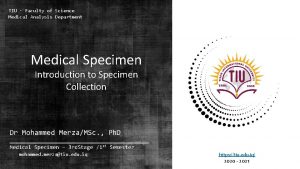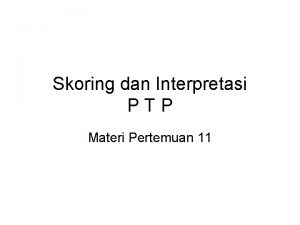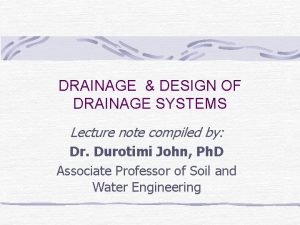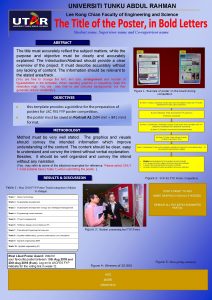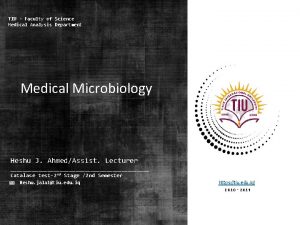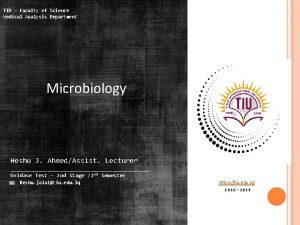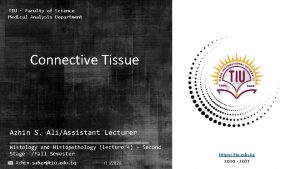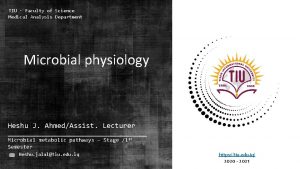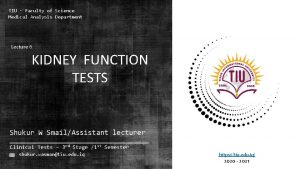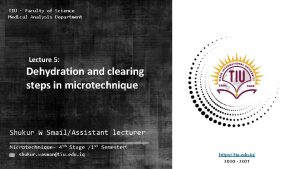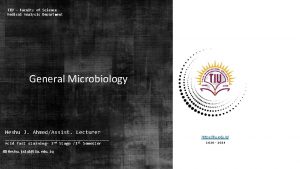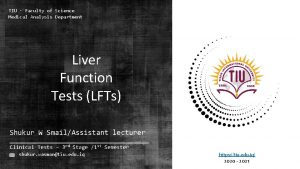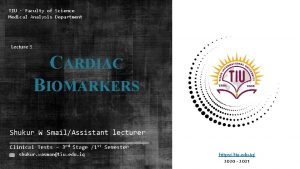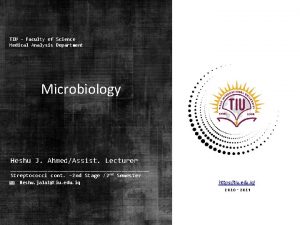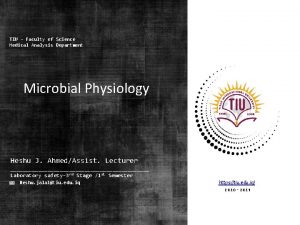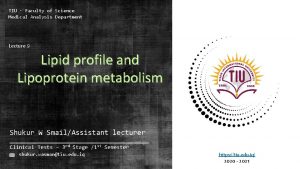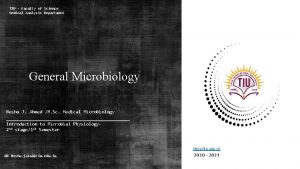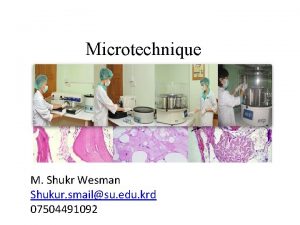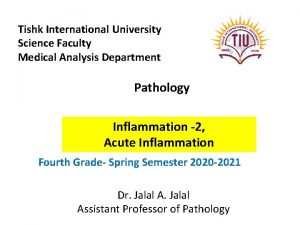TIU Faculty of Science Medical Analysis Department Shukur









































- Slides: 41

TIU - Faculty of Science Medical Analysis Department Shukur W Smail/Assistant lecturer _______________________ Microtechnique– 4 th Stage /1 st Semester shukur. wasman@tiu. edu. iq https: //tiu. edu. iq/ 2020 - 2021

? ? Once the tissue is removed from the body it will go through a process of self-destruction. This process is known as autolysis. If tissue is left without any preservation, then a Microbial attack will occur, the process is known as putrefaction.

In the fields of histology, pathology, and cell biology, fixation is a chemical process by which biological tissues are preserved from decay, either through autolysis or putrefaction. Fixation terminates any ongoing biochemical reactions, and may also increases the mechanical strength or stability of the treated tissues.

The basic aims of fixation are the following: To preserve the tissue nearest to its living state To prevent any change in shape and size of the tissue at the time of processing To prevent any autolysis To make the tissue firm to hard To prevent any bacterial growth in the tissue To make it possible to have clear stain To have better optical quality of the cells

1. Prevention of autolysis of the cells or tissue and prevention of decomposition of the tissue by bacteria. Allow long storage of tissues

2. Maintaining the volume and shape of the cell as far as possible It must kill the cell quickly without shrinkage or swelling

3. Consistently high-quality staining particularly routine stain. Must allow staining

4. Rapid action. It must penetrate the tissue rapidly 5. Cheap 6. Non-toxic

1. Volume changes: Fixatives may change the volume of the cells. Osmium tetroxide cause cell swelling. Volume change may be due to: a) Altered membrane permeability, b)Inhibition of the enzymes responsible for respiration c) change of transport Na+ ions.

2. Hardening of tissue: The fixation changes the of the tissue.

3. Interference of staining: Fixation may cause hindrance of of enzymes. –Formaldehyde inactivates 80% of ribonuclease enzyme (RNAse). –osmium tetroxide inhibits haematoxylin and staining.

4. Changes of optical density by fixation: The fixation may cause changes in the nuclei. The nuclei may look like condensed and hyperchromatic. Change of optical density of the nuclei

The fixative can be classified on the basis of the following criteria : A. Nature of fixation • Immersion • Coating • Vapor • Freeze – Drying • Microwave

B. Chemical properties Aldehyde Oxidizing agent Protein denaturing Cross – Linkage

C. Component present Only one chemical present or More than one

D. Action on tissue protein Coagulalative Non – coagulative

1. Immersion fixation 2. Coating fixation 3. Vapour fixation 4. Perfusion fixation 5. Freeze – dry fixation 6. Microwave fixation 7. Heat fixation

(1) Immersion fixation The whole specimen is immersed in the liquid fixative Examples: Tissue samples are immersed in 10% neutral buffered formalin or Cytology smear immersed in 95% ethyl alcohol. The most used fixation in the laboratories.

(2) Coating fixation Spray fixation The spray fixative usually consists of alcohol and wax. This is commonly used in the cytology samples. The spray fixative is used for easy transportation of the slide.

Advantages: a) Fixation of the cells b) To impart a protective covering over the smear c) No need to carry liquid fixative in bottle or jar

Notes: The spraying over the smear should be smooth and steady, and the optimum distance of 10– 12 inches should be maintained between the nozzle of the spray and the smear. The spray fixative usually consists of alcohol and wax. Therefore, this wax should be removed before the staining procedure.

(3) Vapour fixation Both Histology & Cytology samples. The vapour of chemical is used to fix either a smear or tissue section. The vapor converts the soluble material to insoluble material, and these materials are retained when the smear comes in contact with liquid solution.

Vapour Fixative examples: Formaldehyde. Osmium tetroxide. Glutaraldehyde. Ethyl alcohol.

(4) Perfusion fixation The fixative solution is infused in the arterial system of the animal, and the whole animal is fixed. The organ such as the brain or spinal cord can also be fixed by perfusion fixation. Mainly used in research purpose.

(5) Freeze – drying fixation Used for research purpose This technique is useful to study: soluble material very small molecules.

How to perform Freeze – Drying fixation? The tissue is cut into thin sections. Immersed in liquid coolant “Quenching”. liquid nitrogen, Propane & Isopentane. Then rapidly frozen into a very low temperature. keeping it in close contact with chilled metal.

Then ice within the tissue is removed with the help of vacuum chamber in higher temperature (− 30 °C).

Advantages: Excellent for enzyme study No changing proteins No shrinkage tissue Preservation of glycogen

(6) Microwave fixation Microwave is a type of electromagnetic wave. Its frequencies between 300 MHz and 300 GHz. Its wavelength varies from centimetre to nanometre.

It operates with a frequency of 2. 45 GHz and 0. 915 GHz. The electromagnetic field is created by the microwave, and Dipolar molecules (water) rapidly oscillate in this electromagnetic field. This rapid kinetic motion of these molecules generates uniform heat. Homogeneous increase of temperature within the tissue ─every part of the tissue is heated. The generated heat accelerates the fixation.

Factors controlling the temperature rise: The rise of temperature in the microwave heated media depends mainly on: The dielectric property of the media Thermal properties of the material Radiation level Orientation and shape of the object

Advantages: Rapid processing. No change in volume of tissue. Preservation of the tissue antigen and good for immunohistochemistry. Other fixation methods may prevent antibody bindings. It facilitates the staining reaction any bad effect.

Disadvantages: Safety problems 1. The tissue immersed in formalin during microwave fixation may generate large amount of toxic gas. Solution: Overhead hood for the removal of this substance from the microwave. 2. Heat injury.

Applications: Surgical pathology laboratory Electron microscopy after tetroxide fixation Urgent processing of biopsy (e. g. kidney biopsy)

(7) Heat fixation The simplest form of fixation. boiling tissue in normal saline. Boiling an egg • precipitates the proteins Cutting an egg the yolk and egg white can be identified separately. Each component is less soluble in water after heat fixation than the same component of a fresh egg.

The tissue should be free from excessive blood before putting it into fixative.

Tissue must be very thin. Tissue should be thinly cut in 3– 5 mm thickness.

The amount of fixative must be more than the tissue. The amount of fixative fluid should be 20 times more than the volume of the tissue. So that it can penetrate all parts.

The tissue with fixative should be in a tightly screw-capped bottle.

"Basic and Advanced Laboratory Techniques in Histopathology and Cytology" by Pranab Dey Bancroft’s Theory and Practice of Histological Techniques

Thanks for your attention @tiu. edu. iq
 Tiu medical analysis
Tiu medical analysis Quadrant streak
Quadrant streak Contoh tiu dan tik
Contoh tiu dan tik Anne laure wu tiu yen
Anne laure wu tiu yen Kromosom
Kromosom Interpretasi tiu 5
Interpretasi tiu 5 Lecture note tiu
Lecture note tiu Lecture notes tiu
Lecture notes tiu Pm 2.5 adalah
Pm 2.5 adalah C learning tiu
C learning tiu Keralastec
Keralastec Medical faculty in novi sad dean
Medical faculty in novi sad dean Ascaris lumbricoides ova
Ascaris lumbricoides ova Masaryk university medical faculty
Masaryk university medical faculty What is your favorite subject and why science
What is your favorite subject and why science Bridgeport engineering department
Bridgeport engineering department University of bridgeport computer engineering
University of bridgeport computer engineering Lee kong chian faculty of engineering and science
Lee kong chian faculty of engineering and science Florida state university computer science faculty
Florida state university computer science faculty Ucl cs
Ucl cs Iit delhi material science
Iit delhi material science Brown university computer science
Brown university computer science Lee kong chian faculty of engineering and science
Lee kong chian faculty of engineering and science Importance of medical records
Importance of medical records Medical education and drugs department
Medical education and drugs department Northwestern electrical engineering
Northwestern electrical engineering Computer science department rutgers
Computer science department rutgers Department of forensic science dc
Department of forensic science dc Ohio tpes
Ohio tpes Meredith hutchin stanford
Meredith hutchin stanford Ubc computer science department
Ubc computer science department Department of computer science christ
Department of computer science christ Computer science department columbia
Computer science department columbia California medical license for foreign medical graduates
California medical license for foreign medical graduates Greater baltimore medical center medical records
Greater baltimore medical center medical records Difference between medical report and medical certificate
Difference between medical report and medical certificate Torrance memorial human resources
Torrance memorial human resources Cartersville medical center medical records
Cartersville medical center medical records Applied medical science swansea
Applied medical science swansea Swot analysis for procurement department
Swot analysis for procurement department Human resource planning introduction
Human resource planning introduction Swot analysis of hr department
Swot analysis of hr department
